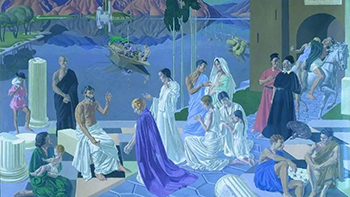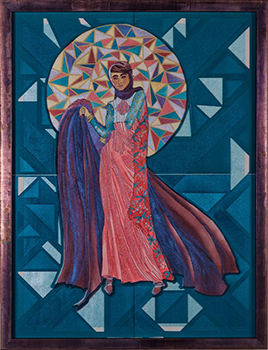From Our Archives
Dan Clendenin, Bottled Lightning (2007); The Glory and Honor of the Nations (2010); Celtic Blessings for All The World (2013); Taking the Long View (2016); Debie Thomas, The Question That Hurts (2019); and Dan Clendenin, The Ends of the Earth (2022).
This Week's Essay
Acts 16:15, "Lydia invited us to her home."
For Sunday May 25, 2025
Lectionary Readings (Revised Common Lectionary, Year C)
Psalm 67
Revelation 21:10, 22 –22:5
John 14:23–29 or 5:1–9
In the Episcopal Church where I worship, on May 21 we will celebrate the feast day of Saint Lydia — the subject of this week's reading in Acts 16. Some Eastern Orthodox churches will also honor Lydia on May 20 with the special title "Equal to the Apostles." Lydia is often remembered rather quaintly as the patron saint of hospitality and dyers, but I would suggest that the sparse details of her story invite a more radical reading.
But first we must backtrack. In my essay last week, I described how in the house of Simon the tanner, a Gentile who handled bloody animal carcasses every day, Peter the conscientious Jew had his vision of unclean animals. Simon was a socio-economic outcast. He was a "dirty" man both literally and figuratively. He would have been the object of social disdain among the cultural elite. Among Jews, he epitomized ritual impurity.
In fact, when the pagan critic Celsus (c.175) made fun of Christians, he combined sarcasm with intellectual condescension. The Christians were riffraff who "work with wool and rags, that is, the least cultured and most ignorant kind." You could find them, said Celsus, "in the women's quarters, the cobbler's shop, or in the tannery." There is some truth in this cheap shot.
 |
|
"St Paul Meeting Lydia of Thyatira" by Edward Irvine Halliday. (1902-84).
|
But Simon the tanner had joined the Jesus movement. He experienced acceptance there that conscientious Jews and cultured Gentiles never gave him. And so Simon the tanner hosted Simon the apostle. It's a fascinating mashup, a sociological snap shot of how the Jesus movement spread like wild fire among down market outcasts. And so the tiny Jewish sect of Jesus followers embraced and then exploded amongst the Gentiles. Radical inclusion subverted religious exclusion and cultural snobbery.
This week is way different. The conversion of the cosmopolitan Lydia in Acts 16 shows how the Jesus movement was also spreading among upscale elites. And Luke emphasizes that she was not the only such person.
Lydia was a Gentile business woman and "God-fearer" from the Greek city of Thyatira, which was famous for its reddish-purple dye. She was on a business trip 300 miles from home in the Roman colony of Philippi. Most translations say that she was a "seller of purple cloth," but this is a bit too precise. I like how the KJV and the ASV retain the ambiguous but literal Greek, "seller of purple."
 |
|
"Lydia" by the Bulgarian icon painter Silvia Dimitrova.
|
We don't know whether Lydia sold purple dye or purple textiles, or whether she was an owner, importer, retailer, producer or laborer. But a "purple seller" or porphyropolis was definitely somebody who was marketing a luxury product to the wealthy elite. In the parable of the Rich Man and Lazarus, for example, the rich man was "dressed in purple, and lived in luxury every day."
Lydia was clearly a woman of means, agency and authority. There are no men in this story — no husband, father, son, or brother, for example. Maybe she was divorced or widowed. After her own conversion and baptism, Lydia commandeered her entire household to be baptized, meaning she employed servants. Perhaps her "household" also included extended family members?
Then, just as the downmarket Simon hosted Peter, the upscale Lydia "prevailed upon" Paul and his companions to stay with her — a large group of foreign men. Lydia's house was large enough to accommodate Paul's entourage, which at a minimum included Paul, Silas, Timothy, Luke, and "the brothers." Luke says that they stayed in Philippi for "some days." That's a lot of logistics.
After the apostles were imprisoned, and then released with strict orders to leave town, they "returned to Lydia's house" (16:40). That was a very brave decision on her part, given that the apostles had just been stripped, beaten, and jailed by a violent mob because of their preaching about a strange sect that Lydia herself had joined. She was effectively harboring criminals.
 |
Since this story is set in Paul's first foray into what we now call Europe, Lydia is honored as the first Christian convert in Europe. Her house was the first church in Europe, and Lydia the business woman-householder-convert-host was clearly its leader and patron. Today you can visit a baptistry near Philippi where Paul baptized Lydia and her household.
Immediately following Lydia's conversion in Philippi, in Thessalonica "a few prominent women" believed (17:4). At the next stop in Berea, "a number of prominent Greek women" converted (17:12). And after Berea, Paul engaged the intellectual elites at the famous Areopagus in Athens, where many in the audience "sneered," but some believed, including a woman named Damaris (17:34).
Whether downmarket outsiders like Simon, or upmarket insiders like Lydia and many other "prominent women," the Jesus movement was breaking the boundaries of gender and geography, race, class, and religion. This movement of rapid expansion was propelled by a message of radical inclusion.
Luke's book of Acts began with a tiny and fearful sect of Jewish believers in the sacred city of Jerusalem. It ends in the secular capital of Rome, in the heart of one of the world's greatest empires. His final sentence in Acts 28:31 describes how, under house arrest in Rome, Paul proclaimed the good news of God's love "boldly and without hindrance" for two years.
 |
|
"St. Lydia" by Amy Zaleta-Martinez.
|
Writing at the same time as the sarcastic Celsus in the late second century, the African theologian Tertullian bragged that Christians had quickly permeated every level of Roman society. "We are only of yesterday and have filled everything you have: cities, apartment blocks, forts, towns, marketplaces, even the military camps, tribes, town councils, the palace, the senate, the forum. We have left you only the temples." Christians in the Roman senate?!
A hundred years after Celsus and Tertulliuan, there came a remarkable historical paradox. Rome had been the greatest persecutor of the church. In the book of Revelation, Rome is Babylon the Great, and a violent Beast with seven heads. Peter and Paul were martyred in Rome. Then, with the conversion of emperor Constantine and the Edict of Milan in 313, Rome became the church's greatest protector and benefactor. Eventually, and down to our own day, Rome became the center of ecclesiastical power and the seat of the papacy.
But even the mighty Roman Empire was only a small beginning. Today Christianity is the world's largest religion, with 2.4 billion adherents all around the world. At its best, it remains a movement of expansion by inclusion, just as with Simon the tanner and Lydia the power broker.
Weekly Prayer
The Book of Common Prayer, 1979, Rite II
Eternal God, who gives good gifts to all people, and who grants the spirit of generosity: Give us, we pray you, hearts always open to hear your word, that, following the example of your servant Lydia, we may show hospitality to those who are in any need or trouble; through Jesus Christ our Lord who lives and reigns with you and the Holy Spirit, one God, now and for ever. Amen.
Dan Clendenin: dan@journeywithjesus.net
Image credits: (1) The God Who Speaks; (2) The Living Church; (3) Prayers and Petitions; and (4) Saatchi Art.





